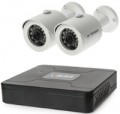Recorder
This parameter refers to the included DVR and describes the types of video signal (and therefore cameras) with which it is compatible. In some cases, the model is also indicated - for connoisseurs of the matter. So you can learn more about the capabilities of the device on specialized sources.
-
Analog. Recorders capable of working only with analog cameras, usually connected via the BNC interface (see below). The functionality of such devices is less extensive than in digital and hybrid models, but they are simple, inexpensive and quite capable of coping with basic video surveillance tasks. We also note that a modern analog recorder usually has video outputs and service interfaces in a digital format - primarily HDMI and LAN (see below).
-
Digital. Recorders designed to work with IP cameras - that is, cameras that transmit video signal through computer networks. This signal format provides improved noise immunity and a greater number of additional features compared to analog. In addition, it allows you to build video surveillance systems based on existing local networks, and cameras can be connected not only by wire, but also wirelessly (see below for more details). On the other hand, digital recorders and cameras are more expensive than analog ones, advanced functionality is not often needed in practice, and the transfer of a large number of video streams can create a high load on net
...work equipment. Therefore, it makes sense to purchase such a recorder only if the described advantages have crucial.
- Hybrid. Recorders that combine the capabilities of analog and digital models - that is, compatible with both analog and IP cameras. This combination allows you to combine the advantages of both types and partly compensate for the shortcomings, but significantly increases the price of the registrar.Max. capacity
The largest storage capacity with which the recorder is able to work normally.
The more capacious the drive, the higher the processing power of the system in which it is used should be. Therefore, any modern registrar has limitations on disk capacity. However, even in the most modest models, this figure is about 2 TB, in most cases this is quite enough to work with the capabilities provided in this particular registrar.
Camera model
A model of pointed cameras supplied with a video surveillance kit. Knowing this data, you can find detailed information on the cameras and clarify their characteristics. Also, if you buy additional cameras of the same model, you don't have to worry about compatibility.
PTZ (managed)
Support of the complete registrar of controllable
PTZ cameras.
Lenses in such cameras are able to rotate from side to side and up and down, as well as change the degree of image magnification (however, not optics, but digital zoom may be responsible for the latter). Thus, the area covered is significantly expanded (although part of it is constantly behind the scenes), and the operator can direct the camera to the point of interest to him. In addition, the movement of cameras can be automated — for example, programmed to constantly turn from side to side, to aim at the door when the lock is triggered, etc.
Support by the PTZ recorder is mandatory for the normal operation of cameras with this function. At the same time, the controlled cameras themselves in this case may be included in the kit, but this is not necessary, so their presence should be specified separately.
HDMI
The number of
HDMI connectors provided in the design of the complete registrar.
The HDMI interface is actually a standard for modern video equipment, it is widely used in TVs, monitors, projectors, etc. Usually, in modern registrars we are talking about HDMI outputs. This output allows you to broadcast a digital signal to an external screen, such as a TV; at the same time, both video and audio are transmitted via a single cable, and the bandwidth is enough to work with HD resolutions and multi-channel audio. The recorder itself can be used as an external video player, to play the footage, or directly broadcast video / audio from the camera (cameras) via HDMI. Models where there are more than one such outputs are practically never found.
Frame rate
The highest frame rate at which the complete recorder can record at full load when all video channels are used. In other words, this is the guaranteed maximum frame rate that can be achieved at any load level (with some channels idle, the number of frames per second may be higher, but not necessarily).
The higher the frame rate, the better fast movement will be captured, the less blurry objects in such scenes will turn out. On the other hand, this indicator directly affects the cost of equipment and the amount of memory occupied by the footage. For video surveillance systems, an indicator of 24 fps is currently considered the minimum necessary, 50 – 60 fps is not bad, and in the most advanced registrars this number can reach 120 fps.

